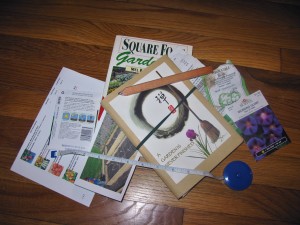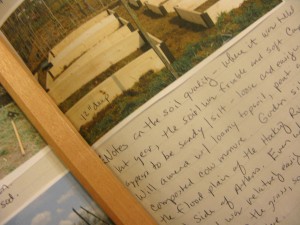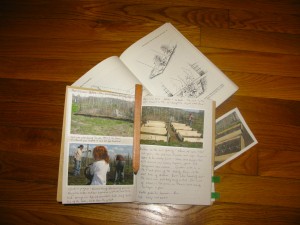The Successful Gardener’s Essential Tool
The greatest tool a kitchen gardener can have to ensure successful harvests is not a shovel, hoe, tractor or tiller. Though to be sure each of those tools are useful and necessary, none of them are the single most useful weapon in the gardener’s arsenal when it comes to getting good harvests year after year.
The essential kitchen gardener’s tool is simply this: a journal.
No, I don’t mean the kind where you record your most intimate thoughts and feelings about broccoli, though, of course, you are free to express those innermost brassical longings–I’m talking about a book (or laptop, for the die-hard geeky gardeners) where valuable data on weather, seed companies, plant varieties, planting dates, expenditures, profits and pests is recorded and kept year after year. All of this data is absolutely useful and crucial to creating a successful kitchen garden not just once or maybe twice, but for years to come.
I know, I know, I’m making all of this sound so boring and complicated. Why have a journal when all you have room to grow is a couple of big planters of tomatoes and a bunch of basil plants on your deck? Why bother with writing stuff down? Gardening is about getting out into the sunshine and the dirt, isn’t it?
Well, I guess that if all you are growing is a few tomatoes and some basil you don’t really need to write anything down about it, but believe me when I say this: you may start out with only a couple of tomatoes and some basil, but if they grow well, you will be amazed at how many plants you can cram into pots on your little tiny deck, and once you get into multiple varieties of the same plant–like tomatoes–you really should try and keep track of what you grow, where, when and how, so that when you come upon a couple of varieties that grow well for you, you can remember which ones they are.
And if you are talking about planting a seriously large backyard or community garden plot, it behooves you to keep careful notes even more, because when you plant more vegetables and fruits, you have more to loose than you did when you just plunked some plants in pots on your patio and called it done. Let’s face it–sure seeds are cheap, relatively speaking–but if you plant a variety that just plain old won’t grow for you one year, and then don’t write that down, what’s to stop you from buying that same variety again next year because you forgot which one did so poorly?
Yeah, sure you MIGHT remember the name of that zucchini that never germinated or that carrot that bolted right away or those eggplants who succumbed to tobacco mosaic virus, but then again, you might not. And really, you can’t rely on the pictures of the vegetables on the seed packs to help jog your memory–lots of zucchini look awfully similar, and many of them seem to be photographed in much the same arrangements on those seed packs. (Because, really, how easy is it to POSE zucchini so they look special and exciting? Can you really see the photographer telling the vegetables to work it? No, me either.)
So, at the very least, a journal is a good place to record your successes and failures so you can repeat the first and hopefully avoid the second next year.
But there is so much a good garden journal can do for you. Here’s a few ideas to get you started….
Keep Track of Expenses: I learned this one from my Grandpa, when I was a fairly little kid. Every time he went to the feed store for a bag of lime or a part for his John Deere, he’d carefully fold the receipt into a neat square and tuck it in the chest pocket of his work shirt, then button the flap over it so it couldn’t slither away and be lost. Then, every night, he’d take out the receipts and record them in his garden journal/ledger in a column marked “Expenses.”
Now, while my Grandpa was a farmer and made his living off the land, his practice is a good one for a plain old backyard gardener to follow too, because it can keep track of where you spend your money in the garden, what you buy, where you buy it, and how long these commodities last.
For example–gardening tools are expensive. BUT, they are usually one-time expenses. I mean, if you buy a good quality shovel or spading fork, and then take proper care of it, it’s going to last at least two decades. Even if you forget to bring it in from the rain and let your clumsy neighbor use it, it’s likely to last at least ten years. So, while it might cost a lot the first year, over the lifetime of its use, that tool will in actuality cost only a couple dollars a year, and the work it will help you do is worth WAAAAAY more than a couple of dollars.
You can make separate categories for your expenses like Grandpa did– tools, fertilizer, pest control, fences, seed starting equipment and hardware (stakes, floating row covers, trellises)–or you can just have one section entitled expenses, where you list everything together. It doesn’t really matter, but what matters is that you keep track of everything, so that at the end of the growing season you can see where you saved money and where you didn’t. If you keep track of what you bought for the garden and how it worked out, you can figured out what was a good investment and what wasn’t so you will purchase more wisely in the future.
Record Plant and Seed Varieties: This is my favorite part of my garden journal. Well, my second favorite part–we’ll get to the other part in a second. Here’s where you keep track of which seeds you plant, when you plant them and where you plant them and how they perform in your garden. This is all crucial information and if you are like me and plant more than one variety of any given vegetable in a year (we have three different types of carrots planted, three kinds of beets, three kinds of peas, two of beans and about six of tomatoes), then you absolutely should not rely on your memory alone to keep straight which varieties grew like gangbusters and which just petered out.
Or, what if you plant a type of tomato, say, that is supposed to be a heavy producer, but for you it only does so-so? I mean, what if it produces some good tomatoes, but not so many as was advertised or maybe not so many as your neighbors got? Well, if you have your journal, you can look at -when- you put it in the ground, where you put it and what the weather was like when it was growing–and you might find your answer there.
Maybe you planted the tomato out in mid-April because it had been warm and then suddenly, it turned rainy and cold and the tomato plant got stressed right away, and maybe it stunted its growth. Next time, maybe you should wait to plant that variety until May first, just to make sure that the temperatures are going to be more consistently warm.
Writing about each vegetable variety you grow is a good way to learn what exactly grows well for you in which season (because you may well find that one type of pea doesn’t produce well in the spring, but is great in the fall) and allows you to experiment with planting times, crop rotation and site selection in an organized fashion.
What should you record about each variety of plant or seed? Well, when I get my seed packets, I usually write down the name of the vegetable, variety name, seed company, germination time and average days till harvest. Then, I go back and after I plant that seed or plant, I record when and where I planted it, and then take notes through the season on how that plant grew in the garden and at the end, I record how much of a harvest I got from that variety.
All of this information is invaluable when you start drooling over the brightly colored seed catalogues that brighten the grey days of January, giving you a means to choose what to order based not only on ad copy and enticing photographs, but also on solid facts that you yourself observed and recorded in your garden.
Oh, and you can organize this section of your journal by seed company, vegetable type, (carrots, tomatoes and lettuces), or if you are really fancy, by vegetable family (brassicas, cucurbits and nightshades). It’s all up to you. I’m doing mine by seed company, but I may switch to vegetable family, just because I like using words like brassica.
Daily or Weekly Garden Log: This is my favorite part of my garden journal. This is where you write about what you did in your garden, what is growing, what isn’t, what beneficial bugs are visiting and what pernicious pests need eradicated, or at least convinced to leave and what the weather is blessing or cursing you with.
This part is fun. Because while writing about expenses is by its nature a simple list and recording facts about seed varieties can be a bit dry, you can make this part of your journal a lot more juicy. You can add pictures. You can wax poetic. You can be witty, funny or ironic. Just make sure to get all the useful, important information into the journal entries while you’re having fun. How much did you plant? How did you plant it? Where? When? How did you dig your garden? Did you use a tiller? Did you double dig? Did you build a raised bed? What did you build it out of? What did you fill it with? Did you see worms in your dirt? Were they active or sluggish? How about those slugs? Carrying a salt shaker in your pocket yet?
See what I mean? There is a wealth to write about when you start recording your gardening activities. And yeah, you can even write a poem about broccoli, if you want. I never have, but that doesn’t mean someone else can’t or won’t.
This is also where you can add photographs recording your garden progress, pressed leaf or flower bits, sketches of a new weed you’ve never seen before and hope to never see again, and garden plot diagrams so you can remember which square foot bit you put the cabbage in and which one is filled with mesclun.
A picture is worth a thousand words, and this is no less true in a garden journal than in any other context. Pictures also help keep you interested in keeping the journal and going back and reading over it later–because really–the truth is, recording all of this data is a worthless waste of time if you go to sleep every time you open it up and try and read it. So, take pictures. Draw pictures.
Hell, make cartoons out of your worst garden enemies, like Santorum Slug or Affleck the Aphid. Turn your resident ladybug into a comic book heroine–whatever works.
Finally, understand that you can use anything to make a garden journal. It can be as fussy and type-A personality or carefree and handmade as you want. It can be analog or digital–it can be a real book or a virtual one. It doesn’t matter. Whatever makes you happy and keeps your data organized and useful is perfectly fine.
Mine is a blank notebook made from recycled materials that I glued the front of a card that was given to me for my birthday by a friend ten years ago. (Yeah, I save stuff like that.) I added little Post-it tabs to make it easy to find my sections for expenses and seed varieties, and will add more as time goes on. I’m kind of winging it with mine by keeping it small and portable, and will have to probably have a different volume for each year, but you could use any kind of small or large notebook or blank book you like.
Or a ledger book like my Grandpa. Or you can buy a special gardener’s journal. Or you can download free templates to make a garden journal. (There are lots of places to download templates.)
Or you could use gardening software.
Or, you could do an online digital garden journal.
Or, you could just start a blog and share your garden journal with the world.
But as for me–I like my plain old analog garden journal, complete with dirty fingerprints and crooked, hand-drawn diagrams. It kind of reminds me of a more heartfelt version of my Grandpa’s extremely valuable and useful, but emotionally sterile, ledger. It’s small enough to take out to my community garden plot with me, but large enough that my handwriting can be read, even by folks other than myself. It’s made from recycled materials, and it looks homey and it expresses as much about me as it does about my garden, and that turns out to actually be important.
Because the truth is this–while the garden journal IS a great tool that helps a gardener reap successful harvests each season, it is also a little bit of a work of art, just as a garden is a work of art.
And like a garden, a garden journal is never, ever finished.
5 Comments
RSS feed for comments on this post.
Sorry, the comment form is closed at this time.
Powered by WordPress. Graphics by Zak Kramer.
Design update by Daniel Trout.
Entries and comments feeds.







I have tomato volunteers, fenugreek, mint, garlic, and some long-bolted rocket. and I HAVE considered keeping a gardening journal ,but am overwhelmed by the amount of recordkeeping i am supposed to do. the work calendar, various project spreadsheets, the housekeeping binder, the ovulation calendar, the secret diary, the happiness journal. aiai.
Comment by chicu — April 20, 2011 #
I WISH I could discipline myself to do this. I guess part of me enjoys being the Haphazard Gardener. Things are coming up and I’m thinking “Hello, what’s this? Did I plant that last year?”
Comment by Theresa — April 20, 2011 #
Thanks for the tip. This wasn’t really on my agenda, but it should be! I’m agonizing about where, how, how big, and with what I should start a new garden this year. A journal is probably a good idea, even if it’s very simple.
Comment by Adrianne — April 20, 2011 #
While journaling probably the best way to approach anything in life as it keeps you on track, I agree with the previous comment that I wouldn’t have the discipline to actually stick the journal but still a great recommendation for those who can to track progress.
Comment by Amy @ As Seen on TV — April 22, 2011 #
Let me let you in on a secret. My ability to keep up with a garden journal has until this season been sporadic at best. However, with this year’s largest garden plot ever, I decided I HAD to walk the talk and actually keep detailed notes on what is planted when and how each variety does. Otherwise, I am apt to make the same mistakes over and over again in years to come.
If that happened, I fear that the shade of my Grandfather would walk the earth again and haunt me until I became a better gardener. 😉
That said, I do not keep a journal for my extensive flower gardening. I should, but I don’t.
Comment by Barbara — April 22, 2011 #